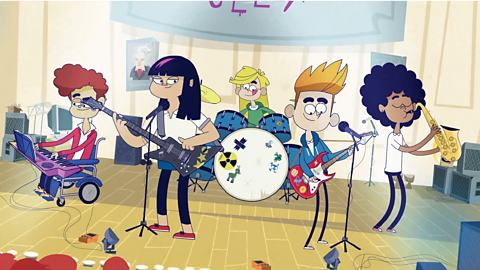Watch: Finding sounds to create music
We can use sounds made with everyday objects, called found soundsSounds that are made from objects which can be found around you. to help us composeTo write your own music. music together.
Watch as a composer and group of children look around their school and record found sounds, to create their own musical compositionCreating or writing a piece of music..
As you watch, make a list of the found sounds and think about how you might use them.
Presenter: Meet composer Jules Rawlinson.
Jules finds sounds everywhere.
Sounds that he digitally records to make unique and wonderful compositions.
Jules: So that's a piece of music that I made using recorded found sounds.
Presenter: It's now time for Jake and Sarah Jordan, Nathan Ailey and Sarah to get to work and start recording.
Jules: So the first thing we have to do is check the sound.
So we hold the microphone in if you want to bounce the ball.
Presenter: Check this out, right…
Student: That sounds really cool.
Presenter: They're bouncing a ball recording the sound.
What's it gonna be?
I don't know, a bass drum or some kind of percussive hit or something.
Student: Recording?
Presenter: Cool sound, guys.
Nice squeaky rusty sound.
Get a good level on there.
Sound good on headphones.
Student: Yeah.
Presenter: Ok, cool.
Now the team is using a hydrophone designed to safely record sounds in the water.
Students: It sounds like like it's fizzing and it's bubbling and stop.
Did that sound good?
Bench stamp, falling stones and peg.
So bench stamp recording.
Presenter: So that's a bench stamp.
This clip is part of the series Compose Yourself from BBC Teach.
Watch: Creating your own composition
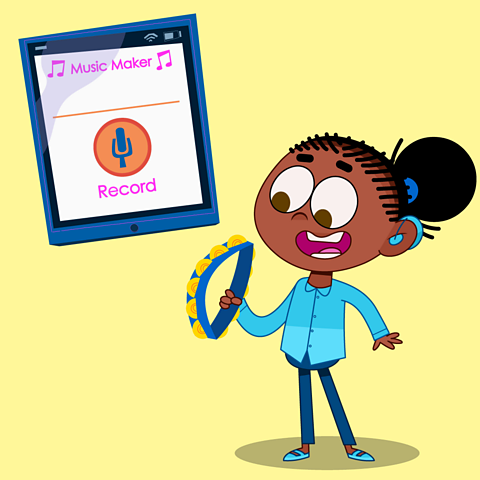
It can be useful to have professional recording equipment when composing, but it's not necessary!
You can collect and record your own sounds on most smartphones and tablets.
When you have collected some sounds of your own, the next stage of the composing process is to experiment with them.
You can:
change your sounds by making them shorter or longer.
organise them into a pattern or sequence to make a piece of music.
mix them together using computer software or an app.
change the pitchHow high or low a musical sound is. of the found sounds. This is like changing the pitch of a sound on a musical instrument.
Listen carefully to how the group use a computer to create a beatThe regular rhythmic pattern of music. from their found sounds.

Narrator: Joel transfers the digital sound files from the recorders so they can begin editing the sounds and arranging music.
Kids: Well, we should really start with a beat. Maybe we should use that ball bouncing.
Jules: That's a great suggestion. So, what we'll do is we'll copy it across into our session.Is that the sound that you meant?
Kids: Yeah.
Jules: Oh, that's a really good one.
Kids: Head teachers cough like in between
Jules: We can do that. Ok that one?
Kids: Yeah
Jules: So let's copy that across then, right? Something like that.
Kids: We could use the spray to go along with the beats.
Jules: Let's see how it sounds.
Kids: Yeah. Yeah.
Jules: Yeah, that's good, isn't it? So we'll start our beat playing and then we can choose where we want to put it.Maybe somebody can click their fingers and we'll know where it should go in the beat.
The, the, so where do you think it should go?
Kids: We could maybe put it in after the second beat.
Jules: That's a really good place to put it.
Kids: And you can put one here too.
Kid Carpet: This is sounding great guys loving this. So, what's making that, diggida - biggida - biggida boom kind of a sound?
Kids: The railings.
Kid Carpet: The railings just out there. Ok. And, what else is in there? It's like a boom, bass drum thing going on. What's that?
Kids: That was a bouncing ball, bouncing the ball in the playground.
Kids: There were feet scuffing on gravel.
Kid Carpet: Scuffing their feet on the gravel and stuff. Yeah.
Kids: The hair teacher coughing.
Kid Carpet: That was really good fun recording that.
Can we do something with the head teacher's cough? Turn into like a, an instrument and make it go.
Can we do that? Yeah.
Jules: Yeah.
Kid Carpet: Yep, that is completely it.
I can't wait to hear this finished.
Jules: So, what I'm doing is using the keyboard to play the cough at different pitches.
Narrator: With some fish tank bubbles laid down. It's time to put melody and rhythm together. And what you get is a kicking dance track.
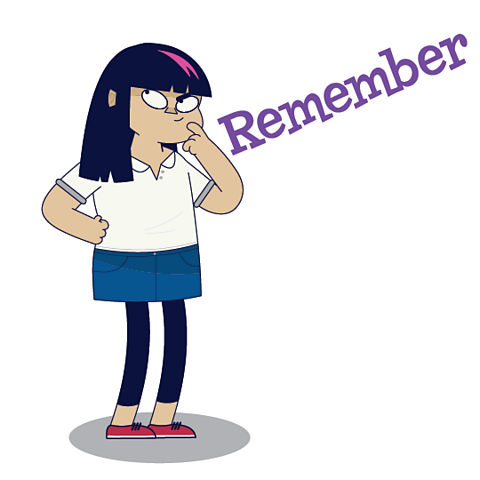
Don't worry if you don't have a computer to do this. You can still use everyday objects and play with your friends, to create and perform your own beat.
Activities
Quiz
SATs preparation resources. activitySATs preparation resources
Get ready for the SATs papers with videos, activities, quizzes and games to refresh your knowledge and practise your skills.

More on Creating Music
Find out more by working through a topic
- count8 of 12
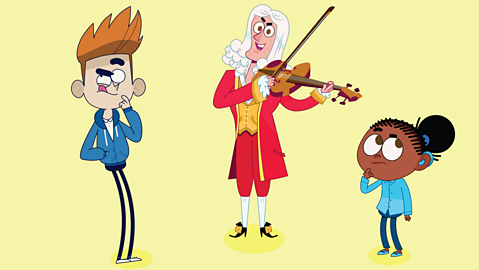
- count9 of 12
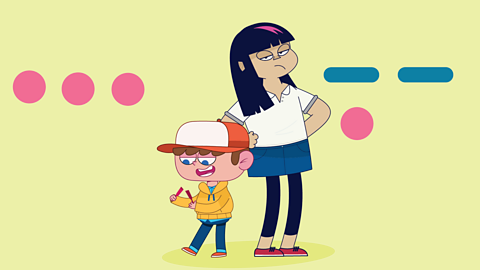
- count10 of 12

- count11 of 12
